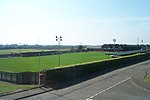Cowdenbeath railway station

Cowdenbeath railway station is a railway station in the town of Cowdenbeath, Fife, Scotland. The station is managed by ScotRail and is on the Fife Circle Line, 22+1⁄2 miles (36.2 km) north of Edinburgh Waverley. The station can be accessed via two steep ramps from either the east side of the High Street, or Station Road, and there is a footbridge connecting the platforms. The ticket office is situated within the waiting room. Additional ticket facilities are provided by an automatic ticket machine outside the waiting room. There is a toilet but to access it, a key must be obtained from the ticket office. There were public toilet facilities in the High Street but these were closed in May 2008; now the nearest facilities are at Cowdenbeath Leisure Centre, a short walk from the High Street. The nearest bus stops, public phones and taxi rank are in the High Street.
Excerpt from the Wikipedia article Cowdenbeath railway station (License: CC BY-SA 3.0, Authors, Images).Cowdenbeath railway station
Union Street,
Geographical coordinates (GPS) Address Nearby Places Show on map
Geographical coordinates (GPS)
| Latitude | Longitude |
|---|---|
| N 56.112 ° | E -3.3431 ° |
Address
Union Street
KY4 9QF
Scotland, United Kingdom
Open on Google Maps







